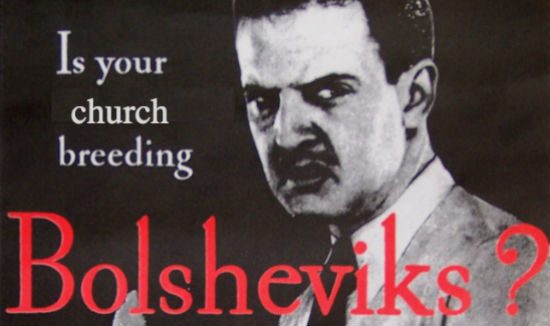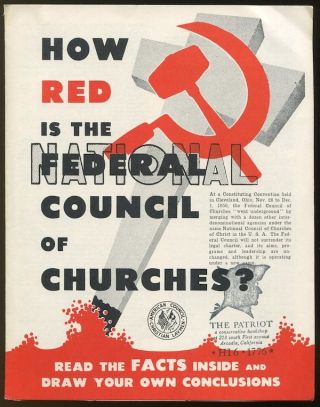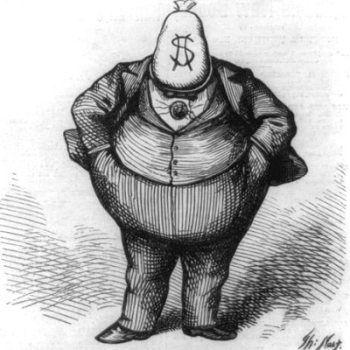There’s a fascinating universe hinted at in this little snippet from Philip Jenkins’ “Billy Graham and the Hell Bombs“:
Though all the mainstream denominations were firmly anti-Communist, the most determined Protestant militancy came from conservative evangelicals and fundamentalists. Such groups framed the Communist menace as only one component of a much larger threat to religion posed by modernism in society, and particularly in the churches.
That view was held by one extremely important family, namely the Pews, who were so central to the state’s Republican politics. In the Cold War years, the family’s main representative was Philadelphia’s J. Howard Pew, who served as president of Sun Oil from 1912 to 1947, and was subsequently chairman of the board. Many of the family’s donations went to support explicitly religious causes.
The main target of Pew’s concern was the National Council of Churches (formed in 1950 from the older Federal Council), which he saw as a hotbed of liberalism indistinguishable from Stalinism. Responding to an approach from evangelical Protestants of several denominations, in 1956 Pew pledged $150,000 a year to fund a new mass circulation magazine, Christianity Today, to counter the “many so-called Christian papers [which] are but a device whereby editors can wear the livery of the church, and do the work of Socialists.”
The National Council of Churches has long been the focus of dark murmurings and conspiracy theories circulating among politically conservative white evangelicals and fundamentalists. And there has never been a shortage of funding for any hack willing to promote those conspiracy theories. No matter how transparently hackish. J. Howard Pew was a pioneer in that funding.
I don’t doubt that Pew was, in some way, a “true believer” in the nonsense he was spouting about the National Council of Churches. I’m sure that, on some level, he “really believed” that the NCC was, as Jenkins puts it, “a hotbed of liberalism indistinguishable from Stalinism.” I don’t doubt that his sleep was troubled by nightmares starring Harry Emerson Fosdick, whose talk of “the brotherhood of man under the fatherhood of God” apparently terrified the oilman. For Pew, bomfoggery was identical to Bolshevism.

But I also can’t help but wonder if Pew’s obsession with the NCC wasn’t partly due to the longtime rivalry between Sun Oil and Standard Oil. I don’t think it was entirely a coincidence that the Sun Oil gazillionaire just happened to choose to pour money into anti-NCC propaganda at the very same time that Standard Oil’s gazillionaire was pouring money into lovely new facilities for that ecumenical association.
John D. Rockefeller was more of a traditional robber baron. He amassed an obscene fortune at the expense of the public, then — like Carnegie and others before him — sought to shield himself from their anger by putting his name on lots of lovely, indisputably respectable public institutions. “Put down the torches and pitchforks, people, I’ve built you a library, a museum, and a hospital.” That kind of thing. Rockefeller viewed the National Council of Churches as a stolidly respectable recipient of that time-honored brand of robber baron philanthropy, and so he built the God Box up on Riverside Drive, alongside the magnificent cathedral he funded for the Rev. Fosdick.* This was simply what robber-baron billionaires did.
While you might think that someone named “Pew” would choose a similar church-building style of purchased respectability, the Sun Oil billionaire chose a different tack. Instead of opiating the masses by using his plunder to build them museums or libraries or churches, thereby insulating himself from their anger, Pew funneled his “philanthropy” into efforts intended to direct that anger elsewhere.
This strategy may be J. Howard’s greatest legacy. Most 21st-century billionaires no longer emphasize old-school attempts to buy respectability or public affection by building institutions for the public good. There are exceptions — like the technocratic altruism of the Gates Foundation — but for the most part, this is the age of “F–k you money.” Billionaires have found they get a better bang-for-their-buck by donating to “causes” designed to redirect anger away from themselves rather than offering mitigating trade-offs in the form of public benevolence. We have Carnegie Hall and The Getty, but not, say, a gloriously appointed Koch Free Public Library.
 Funding anti-NCC propaganda also proved to be an effective way of funding right-wing politics — of using Cold War anti-Communism to combat any perceived threats to the status quo, including the Civil Rights Movement. It was hard to counter the Civil Rights Movement head-on, because the public was astounded at their teaching, for they spoke as one having authority. The most effective response, then, was not to challenge the morality of civil-rights leaders directly, but to insinuate that they were dupes — that they had been infiltrated and were being manipulated by Reds and other outside agitators (false-flag crisis actors, etc., etc. — it’s a very old lie).
Funding anti-NCC propaganda also proved to be an effective way of funding right-wing politics — of using Cold War anti-Communism to combat any perceived threats to the status quo, including the Civil Rights Movement. It was hard to counter the Civil Rights Movement head-on, because the public was astounded at their teaching, for they spoke as one having authority. The most effective response, then, was not to challenge the morality of civil-rights leaders directly, but to insinuate that they were dupes — that they had been infiltrated and were being manipulated by Reds and other outside agitators (false-flag crisis actors, etc., etc. — it’s a very old lie).
White evangelicals were an enthusiastically receptive audience for this anti-NCC propaganda. This was partly due to jealousy over religious “market share,” and to a more resentful jealousy over the cultural influence that mainline Protestants seemed to enjoy in the post-war decades. (Entrepreneurially non-denominational evangelicals also coveted some of the more secular aspects of the NCC — like secure pension funds for clergy.) It was also partly due to the End Times mania of white evangelicals’ Rapture Christianity, which saw the NCC as a kind of religious counterpart to the United Nations — i.e., as a nefarious precursor to the rise of the Antichrist’s One World Government.
But the main reason that white evangelicals have been so receptive to this anti-NCC propaganda is that millions of dollars have been spent making them so. J. Howard Pew was one of the first billionaires to fund such efforts, but he was far from alone. Big “charitable” foundations still pour millions of dollars into this same racket, warning against the danger of “liberal” churches that have been “infiltrated” by globalist conspiracies (Soviet or Soros, it hardly matters). And this has always been in service of strictly partisan politics.
The most explicit example of this is something called the Institute on Religion and Democracy, a right-wing PR-tank founded in 1981 with the explicit purpose of condemning and combatting the Communist influence of the National Council of Churches. IRD managed a few “accomplishments” in the early 1980s as it rallied white evangelicals in support of Apartheid, Salvadoran death squads, and Contras, but as an explicitly Cold War organization, it had to reinvent itself after Glasnost, and then 1989, and then 1991, closed that chapter of history. The former Cold Warriors of IRD are now fierce culture warriors, still funded by the same steady stream of anti-NCC billionaire money and still fueling paranoid propaganda about globalist conspiracies — it’s just that now those conspiracies are feminist, or gay, or (((Soros))).
The reinvention of the IRD is significant because it parallels the reinvention of white evangelical partisanship writ large. In 1981, that partisanship was based on the Cold War — the Most Important Thing and, therefore, the Only Important Thing. In 1991, that identical partisanship was now based on something else — because it had to be. By 1991, both the IRD and white evangelicalism were inherently partisan because of abortion — the new Most Important Thing and, therefore, the new Only Important Thing. The single issue requiring lockstep partisanship had changed, but its function was the same.
– – – – – – – – – – – –
* One of the coolest things about the Interchurch Center is the peregrine falcons. Riverside Church — an impressive edifice that looks a bit like something from Tim Burton’s Gotham — is home to a nesting pair, who are fond of butchering pigeons on the window-ledges of the neighboring office building. Awesome.












